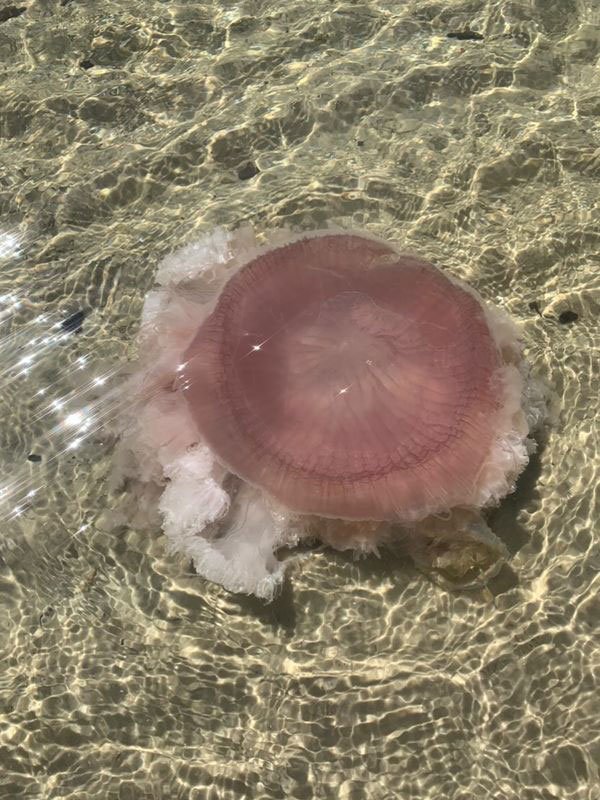Pink meanie jellyfish, also known as Drymonema larsoni, are not only mesmerizing creatures of the ocean but also hold secrets to their stunning coloration that intrigues scientists worldwide. These vibrant jellies, with their graceful tentacles trailing behind, have sparked curiosity among marine enthusiasts and researchers alike. With their distinct pink hue and mysterious beauty, pink meanie jellyfish grace the deep waters, leaving us in awe of the wonders that lie beneath the surface. Join us on a journey to explore the captivating world of these enchanting creatures and uncover the mysteries that surround the pink meanie jellyfish.
The Fascinating Pink Meanie Jellyfish: A Closer Look at This Underwater Marvel
Welcome, young marine enthusiasts! Today, we are diving deep into the mesmerizing world of the pink meanie jellyfish. These captivating creatures, also known as Drymonema larsoni, are a sight to behold in the vast ocean waters. Join me as we unravel the mysteries surrounding the pink meanie jellyfish and learn more about their unique characteristics, habitat, behavior, and importance in the marine ecosystem.
Meet the Pink Meanie Jellyfish
Imagine a delicate, translucent jellyfish gracefully gliding through the ocean waters, its tentacles trailing behind like wispy tendrils. That, my dear readers, is the majestic pink meanie jellyfish. As its name suggests, this jellyfish boasts a stunning pink hue that sets it apart from its gelatinous counterparts.
The pink meanie jellyfish is a species of jellyfish that belongs to the Drymonematidae family. These jellyfish are predominantly found in the warm waters of the Pacific Ocean, particularly along the coasts of Hawaii. Their vibrant pink coloration is a result of the presence of zooxanthellae, which are tiny algae that live symbiotically within the jellyfish’s tissues.
The Habitat of the Pink Meanie Jellyfish
One of the most intriguing aspects of the pink meanie jellyfish is its preferred habitat. Unlike many jellyfish species that dwell closer to the surface, these unique creatures are known to inhabit deeper waters, often venturing down to depths of 200 meters or more. This depth preference sets them apart and adds to their mystique.
The pink meanie jellyfish can be found in a variety of marine environments, from coral reefs to open ocean waters. They are well-adapted to withstand the challenges of deep-sea life, making them resilient and intriguing inhabitants of the ocean depths.
Behavior and Feeding Habits
When it comes to behavior, the pink meanie jellyfish is a fascinating creature to observe. These jellyfish move through the water with effortless grace, propelled by pulsations of their bell-shaped bodies. Despite their delicate appearance, they are efficient predators, using their long, trailing tentacles to capture prey.
The diet of the pink meanie jellyfish primarily consists of small fish, plankton, and other jellyfish species. Their tentacles are equipped with stinging cells called cnidocytes, which they use to immobilize their prey before consuming it. This feeding strategy ensures that the pink meanie jellyfish maintains its place as a top predator in its underwater realm.
Role in the Marine Ecosystem
Every creature in the ocean plays a vital role in the delicate balance of the marine ecosystem, and the pink meanie jellyfish is no exception. As predators of smaller marine organisms, these jellyfish help regulate population levels and maintain the health of the marine environment.
Furthermore, the pink meanie jellyfish serves as food for various marine predators, including sea turtles and certain species of fish. By being part of the food chain, these jellyfish contribute to the biodiversity of the ocean and support the survival of other species.
Threats and Conservation Efforts
Despite their importance in the marine ecosystem, pink meanie jellyfish face several threats that jeopardize their populations. Pollution, overfishing, and habitat destruction are some of the key factors that contribute to the decline of jellyfish populations worldwide, including the pink meanie jellyfish.
Conservation efforts aimed at protecting jellyfish populations are crucial for preserving the biodiversity of our oceans. By raising awareness about the importance of jellyfish and implementing sustainable fishing practices, we can help ensure the survival of these fascinating creatures for future generations to admire and study.
As we conclude our deep dive into the world of the pink meanie jellyfish, I hope you have gained a newfound appreciation for these captivating creatures. From their stunning pink coloration to their role in the marine ecosystem, pink meanie jellyfish are truly remarkable inhabitants of the ocean depths.
Remember, the ocean is a vast and wondrous place filled with incredible creatures waiting to be discovered. By learning more about species like the pink meanie jellyfish, we can deepen our understanding of the intricate web of life that exists beneath the waves.
So, next time you find yourself by the ocean, take a moment to marvel at its beauty and diversity, knowing that a world of wonder lies beneath the surface, including the enchanting pink meanie jellyfish.
Pink meanies spotted on Florida and Alabama beaches
Frequently Asked Questions
What are some key characteristics of the pink meanie jellyfish?
The pink meanie jellyfish, known scientifically as Drymonema larsoni, is characterized by its vibrant pink coloration and long, flowing tentacles. It is a species of jellyfish that can grow to a considerable size and is often found in tropical and subtropical waters.
Where are pink meanie jellyfish commonly found?
Pink meanie jellyfish are typically found in the waters of the Caribbean, Gulf of Mexico, and other tropical and subtropical regions. They are known to inhabit both coastal areas and open ocean environments.
Are pink meanie jellyfish dangerous to humans?
While the pink meanie jellyfish are not considered to be highly venomous to humans, their tentacles can still cause irritation and discomfort if they come into contact with the skin. It is advisable to avoid direct contact with these jellyfish to prevent any potential skin reactions.
How do pink meanie jellyfish capture their prey?
Pink meanie jellyfish use their long tentacles to capture small fish and other prey. The tentacles are equipped with stinging cells that help immobilize and subdue the prey before the jellyfish consumes it. This feeding strategy allows the pink meanie jellyfish to obtain nutrients from a variety of small marine organisms.
Final Thoughts
In conclusion, the pink meanie jellyfish is a fascinating and elusive creature of the ocean. Its vibrant pink color and powerful sting make it both beautiful and dangerous. Researchers continue to study its behavior and impact on marine ecosystems. Understanding the habitat and behavior of the pink meanie jellyfish is crucial for protecting both marine life and human swimmers. Support conservation efforts to preserve the delicate balance of our oceans and prevent encounters with the pink meanie jellyfish.




